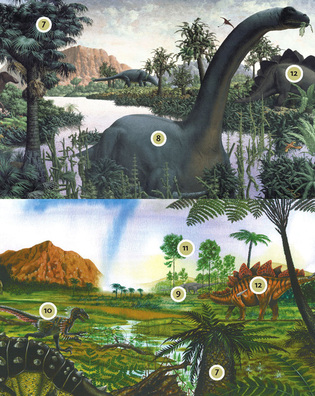 loading
loading
Extreme makeover Top: Rudolph Zallinger ’42BFA, ’71MFA. Bottom: Alan Male.View full image
(7) Palms vs. cycads The Peabody mural features a lush swamp as the landscape of the early Cretaceous and late Jurassic, 110 to 150 million years ago. But much of the flora, says paleobotanist Leo Hickey, was "totally wrong." He finds the wide-leaved vegetation along the edges of the stream baffling: "I don't know what these plants are -- there's no fossil evidence for them." Nor did large palms exist yet. "Rudy [Zallinger, the painter] didn't really have a good feeling for trees," says Hickey. The dominant plants were actually palmetto-like species, smaller than palms; cycads; and lots of horsetails. (8) Water lover? In the 1940s, Brontosaurus was thought to be so massive and slow that it spent most of its time in the water -- both to support its weight and to deter predators. But that's "an urban legend," says paleontologist Gauthier. "An animal that big, which had a big whip attached to its tail, was not at all defenseless." (9) . . . or impostor? In fact, there never really was a Brontosaurus. The fossil that O. C. Marsh namedBrontosaurus was actually the same as a kind of dinosaur he had discovered earlier—the Apatosaurus. Marsh also got the head wrong on "Brontosaurus. " His specimen lacked a skull, so he made an educated, but ultimately inaccurate, guess; the animal had a slimmer, more elongated head. And finally, "we now know that the tail posture is wrong" in the Peabody mural, says Gauthier. Scientists have found that sauropods, the group of massive, plant-eating dinosaurs to which Apatosaurus belonged, probably walked with tails extended straight behind. Indeed, the tail in the Peabody's original "Brontosaurus" display had to be broken for it to drape along the ground. (10) Revolutionary Deinonychus was unknown when Zallinger painted the Peabody's mural. The discovery of this lithe, fast (and perhaps even warm-blooded) predator in 1964 by Yale's John Ostrom launched the current revolution in our understanding of dinosaurs. The feathers in Alan Male's painting are a conjecture—feathers are rarely fossilized, and none have been found on Deinonychus fossils—but a very likely one, as Deinonychus's closest relatives had them. Ostrom suggested that Deinonychus hunted in cooperative packs, like wolf packs, because the animals have been found fossilized in groups and the footprints of many individuals have been found in trackways. But Peabody paleontologist Brinkman thinksDeinonychus was more likely "a solitary hunter in the manner of the Komodo dragon. One lucky predator kills as an individual, and then others in the area smell something and come running. This loose aggregation lasts until the food's gone; it's not a permanent pack." (11) Plant defenses "Think of Apatosaurus, " says Hickey, "as a weedwhacker"—that is, a high-volume plant-eater that primarily consumed brush and ground cover. But it could also reach higher leaves and branches by balancing on its hind legs and tail, tripod-style. Hickey says the shape of Araucaria evergreens, with their needles concentrated high off the ground, may have evolved in response to Apatosaurus and other sauropods. (12) Buff Stegosaurus, another dinosaur named by Yale's O. C. Marsh, was an enigma: what was the purpose of those large plates on its back? Marsh suggested that they covered the animal as a kind of armor, but later fossil discoveries revealed that the plates stood upright. More recent theories hold that the plate and spike patterns in stegosaurs were unique to each species—so they were useful for defense, but were just as important as a colorful means of attracting the opposite sex. And Stegosaurus is no longer thought of as a lumbering, slow-moving beast but as mobile and formidable.
The comment period has expired.
|
|